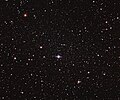Ficheiro:Carina Dwarf Galaxy.jpg

Dimensões desta antevisão: 719 × 600 píxeis. Outras resoluções: 288 × 240 píxeis | 576 × 480 píxeis | 921 × 768 píxeis | 1 228 × 1 024 píxeis | 2 456 × 2 048 píxeis | 3 771 × 3 145 píxeis.
Imagem numa resolução maior (3 771 × 3 145 píxeis, tamanho: 5,64 MB, tipo MIME: image/jpeg)
Histórico do ficheiro
Clique uma data e hora para ver o ficheiro tal como ele se encontrava nessa altura.
| Data e hora | Miniatura | Dimensões | Utilizador | Comentário | |
|---|---|---|---|---|---|
| atual | 13h14min de 24 de fevereiro de 2015 |  | 3 771 × 3 145 (5,64 MB) | FDMS4 | Reverted to version as of 14:03, 28 June 2011. |
| 03h00min de 24 de fevereiro de 2015 |  | 3 768 × 3 144 (5,78 MB) | SteinsplitterBot | Bot: Image rotated by 180° | |
| 14h03min de 28 de junho de 2011 |  | 3 771 × 3 145 (5,64 MB) | Jmencisom |
Utilização local do ficheiro
As seguintes 2 páginas usam este ficheiro:
Utilização global do ficheiro
As seguintes wikis usam este ficheiro:
- af.wikipedia.org
- ar.wikipedia.org
- ast.wikipedia.org
- ca.wikipedia.org
- de.wikipedia.org
- el.wikipedia.org
- en.wikipedia.org
- es.wikipedia.org
- fi.wikipedia.org
- fr.wikipedia.org
- he.wikipedia.org
- id.wikipedia.org
- it.wikipedia.org
- ja.wikipedia.org
- ko.wikipedia.org
- mk.wikipedia.org
- nl.wikipedia.org
- no.wikipedia.org
- pl.wikipedia.org
- ro.wikipedia.org
- ru.wikipedia.org
- si.wikipedia.org
- sk.wikipedia.org
- tr.wikipedia.org
- uk.wikipedia.org
- vi.wikipedia.org
- www.wikidata.org
